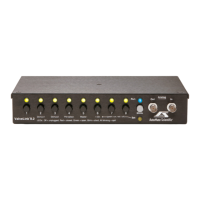Techniques
Dead Volume
Dead volume should be minimized in order to switch solutions as rapidly
as possible. Dead volume for this purpose refers to the volume between
the manifold (or Perfusion Pencil) and nal destination (perfusion
chamber, 96-well plate, etc.) A certain amount of time must pass for a new
liquid to clear the previous one from this nal piece of tubing. Solution
switching takes place at the manifold - assuming each channel’s tubing has
been primed (lled) from its valve to this point. Therefore, the manifold
should be positioned as close to the ultimate destination as possible, while
the valves can be some distance away. The micro-manifolds available
from AutoMate Scientic are designed to be inserted directly into orices
in some perfusion chambers. This absolutely minimizes dead volume –
resulting in bath switching times of under a second.
AutoMate Scientic Perfusion Systems may include a disposable ow
regulator which will increase dead volume if used improperly. The
regulator can either be eliminated if controlling ow rate is not necessary,
or positioned before the manifold to eliminate dead volume. However, this
second method only controls the ow rate of individual solutions (instead
of all solutions when located after the manifold). Therefore, the researcher
can either limit the ow of a single liquid, or purchase ow regulators
for each line.
A nal method for reducing dead volume is to use smaller bore tubing,
although this may also reduce ow rate resulting in the same switching
time as for larger tubing.
Small-bore PTFE Tubing
AutoMate Scientic’s micro-manifolds use
1
/
16
” tube ports which can
either be used with
1
/
16
” o.d. tubing, or enlarged up to
1
/
16
” i.d. tubing for
standard Tygon tubing. Please inquire about AutoMate Scientic’s PTFE
tubing and nut and ferrule valve ttings for small bore use. Also see the
micro-manifold instructions on page 12.
Cutting PTFE tubing at an angle and wetting it makes it easier to insert.
Backflow
When a manifold is used in a plumbing arrangement, none of its ports
can be left unconnected, or liquid will simply ow backwards out of the
opening. Small, green hose clamps are included with AutoMate Scientic
Perfusion System drippers which can be easily attached to short pieces
of tubing to act as plugs for unused holes. AutoMate Scientic also sells
manifold 'stoppers' for plugging unused manifold ports.
Likewise, one must be careful not to open any valve whose reservoir
is completely empty or inow tube is disconnected. Ordinary solution
pressure in other lines will force liquid back up the outow tubing,
through the valve, and either back into the reservoir or out the
disconnected inow onto the oor. Again, clamp-o any unused lines at
the manifold or be sure all valves are closed while changing connections.
Solution will quickly backow into empty tubes even when their valves are
closed because air is so compressible. Fill all tubes down to the manifold
or Perfusion Pencil with solution even if they are not being used.
AutoPrime
™
System
The AutoPrime Perfusion System is
designed to deliver oxygenated (or
other gas-saturated) solutions without
administering ‘stale’ liquid which has
remained stationary in the tubing long
enough to lose its oxygenation. Unless one
uses ‘hard-walled’ (i.e. PTFE) tubing, gas
will escape through the tubing leaving the
stale solution with a ruined pH and gas
concentration. The 8-channel AutoPrime
System uses eight valves per four liquids,
with the second set used as ‘ush’ valves
to waste. Shortly before a solution is to be
switched ‘on,’ its ush valve opens and re-
primes the upper tubing with fresh solution
from the reservoir down to its delivery
valve (where a tee tting is located connected to the ush valve.) The ush
valve is then closed, and the delivery valve can be opened. The previous
solution in a delivery sequence can continue to ow while re-priming
occurs. Contact AutoMate Scientic for more details.
waste

